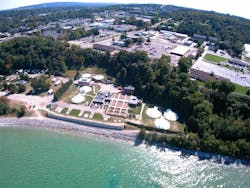Aluminum Domes Combat Odor Control
For more information on CST Industries Inc. go to www.cstindustries.com or call 913. 621.3700.
undefinedLocated along the northern Lake Michigan shoreline, including Little Traverse Bay, the city of Petoskey, Mich., is a resort community and prime destination for both tourists and residents.
The city of Petoskey’s Department of Public Works is designed to treat 2.5 million gal of wastewater daily. Situated near the coastline, the wastewater treatment plant has a popular walking path that is accessible to the public. Odor control and waterfowl, such as ducks and seagulls, were some of the challenges the city needed to address during facility upgrades.
“Our greatest challenges are how to help prevent odor control, waterfowl from landing in the tanks as well as extreme weather conditions and other environmental contaminants,” said Sherrie Elliott, wastewater supervisor for the department of public works. “Petoskey is a four-seasons tourist destination that offers attractions all year round. It is essential for us to maintain a good appearance and go unnoticed as much as possible.”
Needing to cover the wastewater tanks from these elements, the city brought in consulting engineer Hubbell, Roth & Clark, which looked at several options for covering the tanks, including steel, aluminum, flat covers and domes.
“We were looking for a solution that would require little or no maintenance and was aesthetically pleasing to the community around the plant. Being in such a high-traffic area, it is important for us to blend in with the general area, not to mention keep leaves from getting into the tanks, protect equipment and water from subzero weather activity,” Elliott said.
After reviewing product options from three manufacturers, the department went with the consultant’s recommendation of a geodesic dome: an all-aluminum flush batten OptiDome from CST.
CST manufactured five OptiDomes for Petoskey—two primary tanks with diameters of 45 ft each and three secondary clarifiers with diameters of 50 ft each.
During the design phase, the project team overcame some challenges. First, the two existing primary tanks had outboard launders. Second, the load-bearing wall to support the domed covers was inboard from the launder troughs.
The department wanted easy access to view and maintain the weirs, launders and scum trough, so CST incorporated hinged covers around the entire perimeter of the tank. Each cover is about 4 ft wide and can be independently opened and closed to provide operators quick and easy access to the important areas of the clarifier.
“It was a complete product offering, working closely with the consulting engineer, general contractor and the city of Petoskey, giving them the most optimum and aesthetically pleasing design,” said Randy Hamlett of Hamlett Environmental Technologies, authorized manufacturers representative of CST.
The three secondary clarifiers had inboard launders, and the load-bearing wall was the outermost wall of the tank. To provide access for these tanks, CST incorporated vertical sidewalls that elevated the domed cover to a point where operators could walk within the launder trough around the perimeter of the tank while being inside the dome.
“The new aluminum domes, along with the structural design modifications, will provide the city of Petoskey with a long-lasting cover solution for many years to come,” said Julian Perez, project manager for CST.
Perez was impressed with the fact that Petoskey could pick colors and have the domes factory painted. Operators needed to have access inside of the tank and headspace to walk and to see the process to complete the maintenance inside of the domes.
“From the appearance of the domes to its accessibility as well as its versatility, all our needs and expectations were met,” Elliott said.
